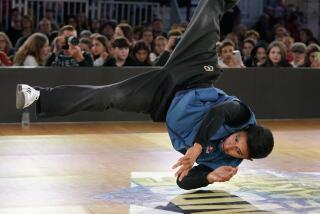CURLING
- Share via
Curling, a game of finesse played with stones and brooms, is making its debut as a medal sport. It is almost unknown in this part of the country, but has many fans and practitioners in the upper Midwest and was an Olympic demonstration sport in 1924, 1932, 1988 and 1992. Curling was invented by the Scots almost 500 years ago. Players slid smooth stones across a frozen pond while partners with brooms swept snow from the stone’s path. The result today is a sort of combination of shuffleboard and bowling on ice.
Terminology
Part of understanding curling is putting aside words familiar for other sports on ice such as hockey and figure skating. A primer:
The teams are called rinks.
The ice rink is called the sheet.
The captain of a rink is the skip.
The rounded granite stone is a rock.
The sliding action is known as curling.
The game is played in 10 periods called ends.
People to Watch
Mike Peplinski the third curler or vice skip on the Tim Somerville rink, the U.S. men’s team. Peplinski, 23, is fighting a degenerative kidney disease and ultimately will require a transplant but has nevertheless made a name for himself in curling circles. He’s a two-time junior national champion, a junior world medalist, a former USOC curling athlete of the year, a Sullivan Award nominee for national amateur athlete of the year and a senior national semifinalist the last two years.
On the women’s team, the Lisa Schoeneberg rink, skip Schoeneberg, 40, and vice skip Erika Brown, 25, have an unusual relationship. Schoeneberg was once Brown’s baby sitter. Schoeneberg is a three-time national champion and a four-time USOC curling athlete of the year, and Brown is a two-time national champion and former curling athlete of the year.
Inside Info
The U.S., with both of its teams, has a far better chance of winning medals than U.S. teams in the more traditional Winter Games sports of ski jumping, cross-country skiing and biathlon. Canada is the recognized power in men’s and women’s curling, but the U.S. rinks are highly competitive. The Schoeneberg rink, of Madison, Wis., finished second to Canada in the 1996 World Championships and may well be in the battle for gold at Nagano.
Norway and Britain -- represented by Scotland, where curling was born -- are added threats in the men’s competition, but the Somerville rink, of Superior, Wis., made the semifinals of the ’95 World Championships and figures to be in the thick of the medal battle.
Equipment
SLIDER AND GRIP: Players wear special shoes--one that grips the ice, the other that slides as the stone is delivered.
HANDLE: A handle is attached to every stone to lift, deliver and release with a “curl”, which is a slight twisting motion.
THE CURLING STONE: Made of dense, polished granite, the curling stone has a diameter of about 30 cm, and can weigh no more than 19.96 kg. It is given a slight twist or “curl” when released.
BRUSH: Used for balance during delivery and for sweeping. THere are two types that can be used--synthertic pads or bristle.
The Playing Field
Curling involves two teams of four players pushing round stones across a measured length of ice. The idea is to have the stone stop in a target area known as the “house.” As stones travel down the ice, sweepers direct them by using brooms. In each of the game’s 10 “ends,” each curler shoots two rocks, alternating with the curlers from the other rink. For each stone closer to the center of the target circles (the tee) than any of the opponents’, a point is scored. There are both offensive and defensive shots, and the strategy is determined by each rink’s captain (skip).
Delivery
Player, using a technique similar to bowling, slides the stone down the ice, starting it with a spin from the “hack,” or starting line.
Sweeping
Sweepers assist the thrower in getting the stone on target. Sweeping the ice with a brush melts the surface, giving the stone momentum to go farther in the desired direction or stop by sweeping shavings onto the stone’s path.
Scoring
The team with the stone or stones closest to the center of the house or “button” wins the end. All stones of the winning team that are closer to the button than is the nearest stone of the opponent are given one point each.
Sources: Associated Press; “The Olympic Factbook/A Spectator’s Guide to the Winter Olympics”; “Winter Olympics Made Simple”; Researched by MIKE KUPPER / Los Angeles Times
More to Read
Go beyond the scoreboard
Get the latest on L.A.'s teams in the daily Sports Report newsletter.
You may occasionally receive promotional content from the Los Angeles Times.






